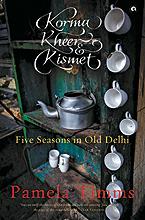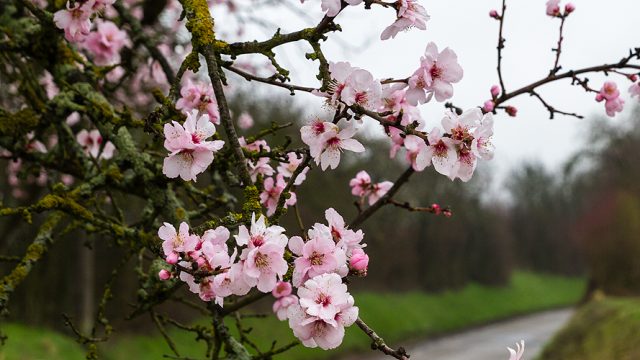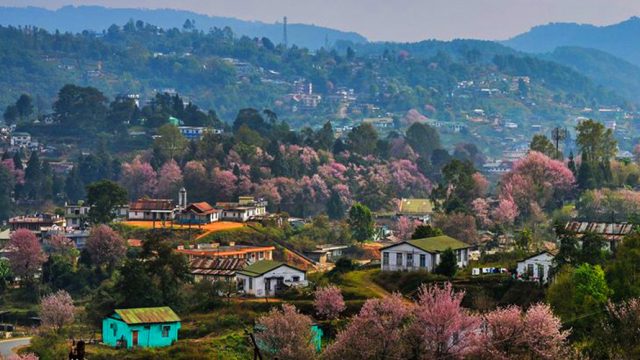Hanami, it’s called, the Japanese custom of viewing flowers, especially the brief visitation of cherry blossoms in spring. Our hanami began in Tokyo’s Haneda airport, where sprigs of sakura decorated jewellery stores, eye-liner vials were displayed against ink drawings of the fragile blooms, and squares of sugary tiramisu, handed over with a deep bow, were purveyed in packs decorated with the graphics of the season. The cherry trees had not yet blossomed in Ritsurin gardens, in the southern town of Takamatsu, and our hosts, bowing deep, apologised for this lapse of nature. But the pine trees were pruned to the perfection of their ritualised art forms, and the koi, the brocaded carp, rose in clouds of colour as a little girl scattered bread sticks on the lake. Carp were once a dull grey species, but after centuries of breeding for colour mutations, first in China, then in Japan, their hues run from a pale tea to a vivid red, and breeders compete for honours in a score of categories. One of these, kumonry, is described as ‘nine tattooed dragons’, plumed white markings on a black fish, which evoke images of dragons painted in ink. We boarded a flat-bottomed boat under a cluster of pine trees, and after we had exchanged bows, the boatman silently punted us out into the clear light of a spring day. A kohaku, a red and white koi, retreated into the shadows as we glided by, the water barely ruffled by our passing. A bubble drifted up from under moss, a drop of water dripped off the boatman’s pole, and my eyes glazed over. “It’s not jet lag or the long flight,” I slurred to myself, “These gardens were designed for contemplation.” As were the teahouses, modest wooden structures where you sat on reed mats, or tatami, and looked out at nature. Nature shaped into a garden by gardeners, engineers and carpenters, working to create harmony between rock and water, living trees and planed wood, flowering shrubs and gravel raked into gentle curves. It can take generations before the endeavour is considered successful — the construction of Ritsurin gardens was begun in 1625, and declared completed only in 1745. Today, the low wooden beams of the teahouse glow with the patina of centuries, and the bonsai pine in the courtyard is gnarled with age and wind. Gardeners work quietly to nurture the aesthetic which created these gardens, and contemporary society deeply treasures the centuries of labour and love that have brought them into being. Green tea is brought to us, in deep bowls to be held in both hands. I ask about the froth of the green tea. It’s whipped up with a traditional bamboo whisk. And the pleasing warmth of the tatami mats? Our guide picks up a corner to reveal an electric under-blanket. I am ushered into my room in the ryokan, or Japanese inn, and the gentlest of gestures tells me where to park my shoes. The room is all tatami and low seating. I put my palm to the floor. No floor heating here. But behind a sliding door, the loo more than compensates, it’s seat warm to the skin, its controls offering ablutions in a wide range of volume, warmth and spray profiles. The work of generations of ceramic designers, hydraulic engineers and electronic programmers! I don my yukata, or kimono, squeeze my size 13 feet into size six slippers, and flop down the hall to dinner, a sit-down meal, with individual little tables carved and painted in traditional designs. Every dish is a work of art, and as a vegetarian, I am amazed by the range of offerings — a broth made of kelp, three varieties of mushroom, the protein skin of soya milk, snow peas, bamboo shoots, river-weed tempura. And my neighbour is in seafood heaven, cycling through red snapper, shrimp, cockles, mussels, bonito, yellowtail, Spanish mackerel, “there’s a whole supermarket of fish on my table!” The next morning, we mount a series of stone steps up Mount Zuzu, flanked first by shops selling souvenirs, then by rough-hewn granite slabs with religious inscriptions, the cherry trees just beginning to blossom. Seven hundred and fifty eight steps up is the Shinto shrine of Kotohira-gu, a substantial temple of undated antiquity, with curved wooden roofs and high open steps leading to the shrine. The massive ship’s propeller in brass installed on the temple grounds looks like modern art shipped to the wrong address. “Also known as Konpira-san, the temple houses the deity of seafarers and fishing,” our guide informs us. That explains the prop, and the fibre-glass boat that circumnavigated the globe. But what about this bronze statue of a dog? “Oh, that depicts a time when bandits roamed the land, and it was dangerous to venture far from home. Rich devotees trained dogs to walk the pilgrim trails, believing that if they reached the shrine, the piety would accrue to their masters.” The next afternoon, our hosts have slotted some secular exercise for us, up in the north of Shikoku Island, where the Seto inland sea separates us from Honshu, the largest of the Japanese islands. From the cycling terminal at Itoyama, the cycle lane cork-screws up three spirals before unspooling out to sea, suspended high above the marine traffic. I could forsake home for this, my Delhi of potholes and smashed beer bottles, of screeching motorcycles and lurching SUVs, leave it for 74 kilometres of riding delight, over nine bridges and down through eight islands, fresh sea breeze in my face, shades of aquamarine and white plumes far below. Another time, maybe one October, when the Shimanami Sea Road is home to a massed fun ride. For now, it’s time to retreat inland, to follow the Iya River up into the mountains, where the Oboke gorge offers whitewater rafting in summer. In early spring, the waters are a slow, clear green, so we make do with a powered boat ride, through canyons of massive sculpted rock, setting off from a jetty festooned with huge carp streamers, celebrating the Day of the Son. Half an hour deeper into the mountains, we walk down to the Iya Onsen gorge, to walk the plank, as it were, of a vine bridge. Deployed 800 years ago, the vines made it easy to hack down the bridge if the resident clan had to make an escape. But they also make for a swaying, lurching passage, and in a moment of panic, I could picture the whole organism unravelling in slow motion, leaving us dangling over cold, rushing waters. But we crossed to the other side, one of our party drew deeply at his cigarette, and I noticed the stout steel cables that lay underneath the camouflage of vines. Adventure tourism, I once read, is the illusion of danger. In 2010, Japan experienced real danger, when a tsunami ripped into the nuclear reactor at Fukushima. Hundreds of square kilometres were declared unsafe for habitation, and there was a threat of widespread radioactive contamination. Media observers commented on the orderly nature of the evacuation and the social cohesion in Japan. Temples across the nation prayed for peace and safety, and devotees strung millions of origami cranes onto bamboo stands, each one a token of solidarity, in intent and in its uniform elegance. Every interaction with the people of Japan underlines their extreme discipline, their infinite courtesy and grace. Parks in every city are stringing up paper lanterns for hanami. And in every city, horticulturists monitor the progress of blooms on the one tree designated as the local benchmark. On our third night on Shikoku, as we drive into the port town of Kochi, we get word that the sakura are in full bloom. I wake early and lope up to Kochi castle, the streets empty except for a knot of young athletes heading back from the stadium. Their fluorescent vests and skimpy shorts admit of no nationality, but when they stop and bow to this stranger, I know I will miss the grace of Japanese life. The castle entrance is draped with paper lanterns, and as I ascend, a group of older women wind down from their hanami. I savour the bower of cherry trees, the clear sky of spring, the gleaming castle. Then a young man in a dark windcheater sets off a whine, a quadcopter rises above us, and he monitors its progress on his iPad. The information Getting There Visa Currency Where To Stay What To See & Do Takamatsu An exquisite window into Japanese culture, Ritsurin Gardens (7am–5pm daily; ¥400 per entry) covers 75 hectares of meticulously maintained grounds, with an ancient teahouse and a lake stocked with koi. Climb 785 steps to one of Japan’s most ancient and revered Shinto shrines, Kotohiragu (8am– 5pm daily). This is the kind of bridge Tarzan would have built — vines lashed to stout trees; cross a deep gorge over the swaying Iya Kazura vine bridge (sunrise– sunset daily; ¥500).
We flew JAL from Delhi to Tokyo, and thanks to a business class upgrade, had a most luxurious flight out. The return flight in economy was surprisingly roomy. Both JAL and ANA operate daily flights Delhi to Tokyo. From other Indian cities, it’s a one hop-flight, which also means you can choose a host of eastern carriers. Expect to pay `50,000 for a return, depending on dates and carrier. JAL Express flies to two cities in Shikoku — Takamatsu and Tokushima; we flew into one and out from the other. If you’re not stopping in Tokyo, remember you need to transfer from Narita airpot to Haneda. Allow for 90 minutes travel time. The limousine (bus) costs ¥3,000 per head.
Tourist Visas can be obtained via VFS and the Japanese Embassy (011-26876581, in.emb-japan.go.jp) at a cost of Rs 500.
1 Japanese Yen (¥) = 60 paise
Takamatsu Kiyomisanso Hanajyukai (from ¥16,350; +81-87-861-5580, hanajyukai.jp), a ryokan atop a hill overlooking the city, offers lovely Japanese-style rooms, with tatami mats, and comfy mattresses made up for the night.
Kochi Brilliantly located, just 2 minutes away from the castle and park, the Crown Palais, New Hankyu (from ¥15,640; +81-88- 873-1111, hankyu-hotel.com) is a city hotel in the western mode.
Tokushima Grandvrio Hotel(from ¥13,910 per night depending on availability; +81-088-624- 1120) is beautifully located near the waterfront.
Getting Around
Shikoku has an excellent network of roads, and since it is mountainous, you will drive through innumerable tunnels. Fast, reliable buses connect the cities with each other, and are cheaper than trains (expect to pay about ¥2,000 for a bus journey from one Shikoku city to another). If you are planning to spend a couple of days on the island, buy the Shikoku Free Ticket on Japan Rail (¥15,700). Valid for 3 days, this ticket allows unlimited travel on all railway lines of JR Shikoku. The Japan Tourism website(jnto. go.jp) gives details for the train pass, as well as a good itinerary for Shikoku, which covers most of the places of tourist interest we visited. For train fares and bookings, use hyperdia.com.
Kochi Gleaming with fresh paint, Kochi castle (grounds: sunrise–sunset daily; castle tower and Kaitoku palace: 9am–5pm daily; ¥400) is a medieval structure overlooking a bustling modern city. If you’re missing the spice of Indian food, spend the evening at Hirome market which has an Indian stall run by boys from Delhi.Itoyama A cyclist’s dream come true — 74 kilometres of dedicated cycle track, suspended high above the sea, down into islands, and then back up again. Set off from Sunrise Itoyama Cycling Terminal, which also hires out cycles (Apr–Sep: 8am–8pm, Oct–Mar: 8am–5pm daily; cycle hire: ¥500 per day; ¥1,000 pick-up fee if the bike is dropped off at another location; ¥800 for 4hr for a cycle with electrical assist).
Top Tip
If I returned to Shikoku, I’d go to the Ritsurin gardens, and spend a day (or two) taking a cycle over the Seto Inland Sea.
Japan
Kochi Castle
Oboke gorge





